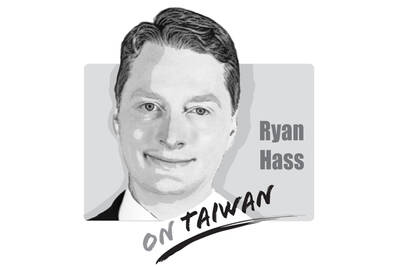President William Lai’s (賴清德) announcement on Friday last week to increase defense spending to at least 3 percent of GDP this year via a special budget is a welcome and long-overdue measure. The spending commitment demonstrates to Taiwan’s allies its commitment to bolstering deterrence and sends a clear signal of military resolve in the face of Beijing’s threats.
Spending more on defense helps to stabilize the region by reinforcing the “status quo” and reduces the strategic burden on the nation’s allies, allowing for a more balanced distribution of security responsibilities in the region. It also helps Taiwan assert more strategic autonomy in defending itself.
The announcement was clearly planned long in advance. After US President Donald Trump’s election victory in November last year, the Financial Times reported that Taiwanese officials were planning a special budget of up to US$15 billion to purchase an “aggressive package of American hardware” to demonstrate that the nation is serious about defense.
However, the report also sent mixed signals, as it said that in addition to procuring Patriot missiles, Taiwan would seek to procure traditional platforms such as F-35 jets, Ticonderoga-class cruisers and Oliver Hazard Perry-class frigates. Although the big-ticket items would be important platforms to counteract Beijing’s “gray zone” air and sea incursions, they are not cost-effective, would take too long to deliver, are not conducive to asymmetric warfare and would do little to bolster deterrence against a Chinese invasion.
Such purchases would not be in line with the defense priorities of the Trump administration, which is for Taiwan to prioritize asymmetric warfare and focus on “deterrence by denial” — a military strategy of making the cost or risk of an invasion too high — rather than going toe-to-toe with China’s much larger forces at land and sea.
For this Taiwan would need to procure weapons such as drones, anti-ship missiles, high-mobility rocket launchers and cruise missiles.
As Institute for National Defense and Security Research fellow Su Tzu-yun (蘇紫雲) said, purchasing more arms from the US should be made with Taiwan’s strategic needs in mind. Only after acquiring sufficient missiles and drones should Taiwan turn back to acquiring larger platforms.
While Lai did not announce what Taiwan would procure with the special funding, sources have said the package would include coastal defense cruise missiles and High Mobility Artillery Rocket System rockets. These are positive signs and show that Taiwan and the US are trending toward the same page on defense procurements.
The question is whether the Chinese Nationalist Party (KMT) and the Taiwan People’s Party, which have a combined majority in the legislature, would acquiesce to defense budget increases and approve the special budget. They have already caused plenty of chaos by attempting to cut and freeze the central government’s budget and the defense budget.
The KMT has previously harmed the nation by blocking defense budgets. In 2001 during the administration of then-president Chen Shui-bian (陳水扁), the US approved a massive sale of arms worth more than US$15 billion, but the pan-blue camp blocked consideration of the special budget 56 times. The government had to give up, and late in Chen’s second term a watered-down version of the arms package totaling US$194 million was passed, not as a special budget, but added to the normal defense budget.
These farcical proceedings not only harmed Taiwan’s defense modernization, but also sent a signal to the US and other allies that the nation was not serious about improving its defense capabilities.
For regional stability, Taiwan’s self-defense and its reliability as an ally, the nation cannot afford a repeat of that episode.

There are moments in history when America has turned its back on its principles and withdrawn from past commitments in service of higher goals. For example, US-Soviet Cold War competition compelled America to make a range of deals with unsavory and undemocratic figures across Latin America and Africa in service of geostrategic aims. The United States overlooked mass atrocities against the Bengali population in modern-day Bangladesh in the early 1970s in service of its tilt toward Pakistan, a relationship the Nixon administration deemed critical to its larger aims in developing relations with China. Then, of course, America switched diplomatic recognition
The international women’s soccer match between Taiwan and New Zealand at the Kaohsiung Nanzih Football Stadium, scheduled for Tuesday last week, was canceled at the last minute amid safety concerns over poor field conditions raised by the visiting team. The Football Ferns, as New Zealand’s women’s soccer team are known, had arrived in Taiwan one week earlier to prepare and soon raised their concerns. Efforts were made to improve the field, but the replacement patches of grass could not grow fast enough. The Football Ferns canceled the closed-door training match and then days later, the main event against Team Taiwan. The safety
The Chinese government on March 29 sent shock waves through the Tibetan Buddhist community by announcing the untimely death of one of its most revered spiritual figures, Hungkar Dorje Rinpoche. His sudden passing in Vietnam raised widespread suspicion and concern among his followers, who demanded an investigation. International human rights organization Human Rights Watch joined their call and urged a thorough investigation into his death, highlighting the potential involvement of the Chinese government. At just 56 years old, Rinpoche was influential not only as a spiritual leader, but also for his steadfast efforts to preserve and promote Tibetan identity and cultural
Former minister of culture Lung Ying-tai (龍應台) has long wielded influence through the power of words. Her articles once served as a moral compass for a society in transition. However, as her April 1 guest article in the New York Times, “The Clock Is Ticking for Taiwan,” makes all too clear, even celebrated prose can mislead when romanticism clouds political judgement. Lung crafts a narrative that is less an analysis of Taiwan’s geopolitical reality than an exercise in wistful nostalgia. As political scientists and international relations academics, we believe it is crucial to correct the misconceptions embedded in her article,